London Fashion Week: East End designers go back to the 80s
East London designers brought a dash of daring and surprise to London Fashion Week Spring/Summer 16, with eighties nostalgia and experimental knitwear referenced on catwalks and in presentations.
Peter Jensen, based on Shacklewell Lane, referenced sixties and eighties Americana in his SS16 presentation, with pinafores and shirt collars, stitched name badges, polo shirts and jean jackets in primary colours. Monochrome prints on Jensen’s signature twin sets and sweaters were paired with visor-helmets for a futuristic twist.
Also playing with black and white was Phoebe English with her deconstructed collection in silks and taffeta. Shirts looked like they’d been unstitched and put back together; Japanese ties, ruched fabric straps and sashes of fabric were used as simple tech-free fastenings.
Leather stirrups, silk ruched Bardot tops and opaque white tights were brought to life at Claire Barrow’s presentation through her surreal illustrations and dystopian messages. Models wielded musical instruments against a dark backdrop of draped fabric and wore vintage drawn-on jeans, jumpsuits and oversized power suits, reminiscent of a moody eighties band practice. For her twisted vision of Dallas, Barrow used a lot of silk fabrics as her canvas, challenging the feminine ideal and playing with sensuality, heightened by the mixed-sex casting.
Faustine Steinmetz was acknowledging her tools and craft for SS16, with garments looking like they’d been pulled off the huge handlooms, which she works on in her East London studio. Denim jackets disintegrated into loose threads at the bottom, curtains of thread made for casualwear motifs on sweaters. For her presentation the French designer had models coming out of the walls, missing limbs, which only enhanced the distorted proportions of the clothes and the surreal element of her collection.
Crash and repair were themes for Christopher Kane’s SS16 collection, and his use of deconstructed fabric and pulled threads reinforced these ideas, turning them into motifs on sweaters and fringing on skirts, this time in primary colours. The collection was unpredictable and varied in its offer, from abstracted wavy cloud silhouettes and rainbow fades, to geometric panelled dresses and block colour shifts interjected with sheer rubberised panels. The designer, whose headquarters are still based in Dalston despite his global success and flagship West London store, brought something new and something old to the collection with unfinished knitwear and his signature fluoro lace. Christopher Kane plastic tags around necks and in hair brought a DIY edge to the collection.
Newcomer Roberta Einer’s eye-popping palette and use of textiles garnered attention at her off-schedule presentation. The recent graduate produced feminine slips and flared skirts in aquamarine and candy pink, incorporating eighties Americana motifs and soviet artwork into her illustrations, which were made out of hand-dyed beads and sequins.
Feminine shapes, whether reimagined or challenged, were evident across the board at fashion week. A vein of eighties nostalgia – bold colours and geometric shapes – was also a reoccurring theme and many designers acknowledged the craftsmanship of their work and that of the industry, by playing with finishings, fastenings and thread.


